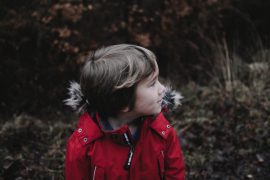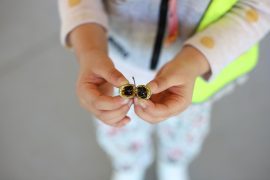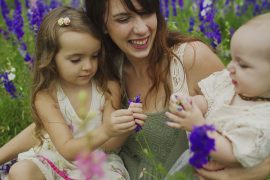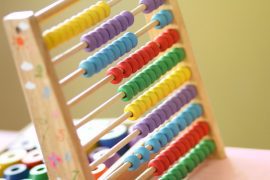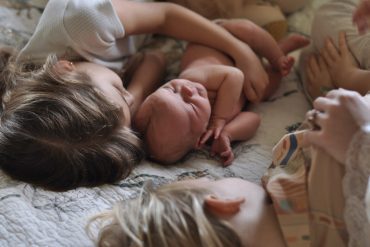Learning to move, moving to learn
The brain and body are one unit. We are forcefully reminded of this when we see someone who has had a stroke. Biologist and educator Carla Hannaford calls movement “the architect of the brain”. Movement builds brain connections and brain computing capacity, and the play that is coded into babies and children demands that they move. As they learn to move, they are learning to learn. Babies, when they are awake, follow their inbuilt choreography and move, on average, once every thirty seconds. Parents who don’t understand this design feature can unwittingly thwart development with any number of the commercial gadgets designed to stop a young child from moving. Various seats, swings, and devices that ‘prop baby in a standing or sitting position’, ‘hold baby in a prone position’, ‘entertain while educating’ are the restraints many babies have to endure. According to Carla Hannaford’s research, many babies spend up to thirty waking hours a week in restraining devices. While the stated intention of the manufacturers is unlikely to be “To stop learning and growth”, the reality is that devices that restrict the natural movement of a baby do just that. (Other than the sling, but that’s another story.) You become an ‘assistant architect of your child’s brain’ by ensuring your baby is free to move. That simply means placing her on her back during her waking play time. That is all the help needed from you. Being on the back gives scope for the kicking of legs, waving of arms, and turning of head required to develop the strength and balance needed to go from prone to standing. It is in the design – trust it.
Inside or outside?
Recently I visited a childcare centre where the staff responsible for children under two years old were in despair. Their new room wasn’t compatible with the design needs of the twenty five babies ‘calling this place home’ for most of their waking hours. A teacher worriedly explained, “When we open the door, all those who can move try and escape.” That’s a testament to the innate wisdom of babies, and a clue for the adults: Given the choice, babies and children prefer to play outside. Given that children who are allowed to unfold their movement to the dictates of their own timetable are so agile and at-home-in-their-bodies that they want to run, climb, balance, chase, and execute spontaneous leaps in the air, outside is probably the ideal place. How many children run foul of adults for running inside, jumping on the couch and climbing on the table? I’m not advocating they use your furniture as their gym, but unless they get to do the learning their being is aching for in a more appropriate setting, prepare yourself: it is on the cards they will back flip onto your settee. They cannot help themselves really. Life is expressing itself through them. And be honest. Didn’t you jump on the beds even though you knew you weren’t allowed to? The push for play and learning is inordinately strong, channel it appropriately.
Social animals
Studies of the social cultures of wolves, horses and other highly social mammals have astounded researchers in the complexity and subtleties – all of which are prepared for, grown and embedded through play. Play grows social creatures, humans included. The mother-child partnership lays the foundation. From there, the young learner branches out to cooperating with others, learning to take turns leading and following, learning to negotiate, learning when to hold on and when to back down, and learning how to manage emotions appropriately when things don’t quite work out as intended. These learnings set the child up for the happiness that comes from being part of a creative functioning ‘family of friends’. They are learned almost effortlessly in the early years because unlike adults, children don’t have ‘stuff going on their heads’. Young children live and play in the present moment where there are no grudges. You will have noticed this: one minute fighting, and next minute best friends again. So how do we support this important play and learning?
Support don’t solve
When children are getting the hang of playing cooperatively in those first three years our job is to keep an eye on things, to ensure that children don’t hurt each other. When conflict boils up during negotiation, we prick up our ears ready to support. This role requires the highest level of self awareness on our part because children’s conflict almost always triggers deep discomfort in adults. Consequently, instead of allowing children to learn the art of negotiating when conflict arises, adults race in and shut down the learning opportunity. “Henry, polite boys do not snatch.” “If you are going to fight over it, I’ll put it up and neither of you and have it.” “Sarah had that first, give it back and you can play with this one”. “You hurt Hana when you grabbed that. Now say you’re sorry”. These common ‘lock-down’ tactics don’t model respectful cooperation; they model the same ‘power over’ dynamic that adults are intervening to correct. If you haven’t already, learn to keep children safe without entering into judgement, breathe through your own discomfort, and give children the space children sort it themselves.
Higher Learning
The play we have glimpsed leads straight into higher learning. The highest of all human capacities is exercising the ‘great human creative thinking brain’ in imaginative play. Children who are left alone to get on with their own imaginative play practise the highest skills of human achievement – making an image in the mind, acting on it, and bringing it into creation. This is a phenomenally complex process achieved with ease by every child who has time and space for self-chosen uninterrupted play. This carton becomes a house, that log becomes a ship, “you be the carpenter and I’ll be the plumber”, these stones build a cathedral, this idea becomes a musical called Cats, these components become the Apple computer, this idea becomes the Hubble Telescope, this idea is expressed e = mc2.
Space for play
Given the right conditions your child cannot ‘not learn’. You are the person who makes sure your child is one equal half of the warm, safe child-adult partnership characterised by unconditional love. You open the doors for play outside in Earth’s garden. You are also the person who realises that TV and computers cannot match any aspect of a child under seven’s learning and developmental design. You resist the temptation to ‘hothouse’ and start ‘school stuff’ before school, and lastly, it is you who are The Keeper of The Diary. You decide if your child’s life is a round of ‘this class and that activity’, or if the diary reserves the sacred space your child requires for learning through self chosen, uninterrupted, creative play.


